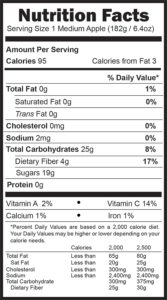How to Read The Nutrition Label
Almost every food we consume has a nutrition label that includes serving size, calories, total fat, cholesterol, total carbohydrates, and protein. However, it leaves us with more questions than answers. How many carbs aren’t recommended for consumption? How much of this food am I supposed to eat if the serving size is so small? Here, we will break down the purpose and parts of a nutrition label.
ex.) Nutrition label of an apple:

Credit: https://www.stemilt.com/farm-to-fork/health-nutrition-apples/
Serving Size
Starting at the top of the label, the serving size represents the average amount of food a person consumes. It is used as a standard unit to measure the nutritional value of the food, not the amount of food you’re suggested to consume.
Amount per serving
What follows is the breakdown of how much of the nutrients can be found in the food.
% Daily Value
It shows the percentage of nutrients in a serving that goes towards a 2000-calorie diet (recommended by the U.S. government). According to the FDA, 5% or less DV is low while 20% or more is high. Learning how to read % Daily Value is important because it helps you identify foods with a higher concentration of nutrients that many Americans lack in their diets, such as calcium, potassium, and vitamin D.
Calories
Much controversy lies over this as it is often used as a metric for diet goals to lose weight. It is simply a unit of energy. On the nutritional label, “large calories” (kcal) are shown. In exact terms, it is the amount of energy needed to raise 1 kg of water by 1 celsius. Calories are important to break down the nutrients in our body.
How should I interpret the Nutrition Label when shopping?
The FDA generally recommends that Americans eat more dietary fiber, Vitamin D, Calcium, Iron, and Potassium. Therefore, you should find foods at your grocery store or supermarkets that have nutrients on their label with a high daily value. However, you should find foods that have a lower daily value of nutrients such as saturated fat, sodium, and added sugars, a.ka. sugar added to the food when it is being made, because they aren’t good for your health if too much is consumed. It is important to know how to read a Nutrition Label because it empowers you to make an informed decision about the foods you are buying, a choice that is valuable for the over two dozen neighborhoods in New York with limited food options.